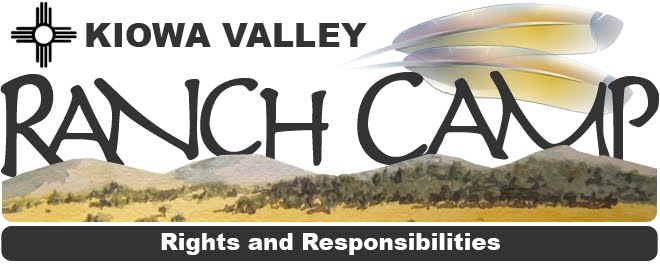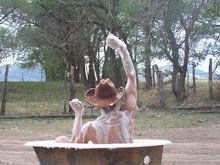
"The Ranch is an undeveloped primitive setting with natural setting and variety wildlife, which requires vigilance and planning for a safe and enjoyable trip."
Ranch Camp LLC assumes no responsibility
Precautions:
Daily life involves following a basic set of precautions to ensure longevity, but a visit to Ranch Camp comes with its own set of safety rules. Always be aware of the dangers described below, and know what to do in hazardous situations. It could mean the difference between a memorable vacation and one you would rather forget!
Wildlife
One of Ranch Camp’s greatest attractions is its diverse wildlife. However, wildlife is inherently unpredictable, and all species are capable of causing serious harm to visitors. Buffalo may appear to possess a relaxed, slow-moving nature, but they are actually very aggressive. Every year, tourists approach bison too closely, and as a result, severe injuries occur. Other large animals, such as elk, moose, deer, and bears, also pose a threat to your safety, and animals with their young in tow can be especially hostile. Never approach wildlife, and remember it is suggested to avoid advancing within 25 yards of all wildlife. For the safety of everyone, take wildlife photos from a safe distance or the protection of your vehicle.
Rattlesnakes
Ranch Camp visitors rarely spot rattlesnakes, but the poisonous snake does reside in Kiowa Valley. Reaching up to four feet long with a rattle on their tale, rattlesnakes bear brown skin with dark splotches. Most rattlesnakes will retreat unless threatened, but a bite can be fatal to humans if not treated quickly and properly. Visitors should be especially careful near rocky areas, as snakes frequently sun themselves on rocky ledges. If you hear a rattle, stop and slowly move in the opposite direction of the sound. If you are bitten, immobilize the area, and immediately seek medical attention. Some snakes are harmless but it is best to treat them all with caution.
Ticks
Ticks and tick-borne illnesses are rarely reported in Kiowa Valley, but visitors should still be aware of ticks, the diseases they carry, and protection methods. Ticks carry and transmit Lyme disease, which can create severe problems when the disease is advanced. To protect yourself from ticks, spray an insect repellent containing DEET directly onto your clothes. Wear light-colored clothes so as to easily spot ticks, and frequently check for ticks on your clothing, skin, and scalp. Remember that ticks’ primary habitats are grassy areas situated at 4,000 to 6,500 feet above sea level. Although ticks are most commonly found between March and mid-July, a few do linger into fall. Practice precaution in all seasons.
Sun Exposure and Illness
Due to the Ranch Camp’s high elevations, Kiowa Valley visitors are more susceptible to high levels of ultraviolet rays, which may in turn lead to heat-related illnesses. Visitors should take every precaution to avoid over-exposure to the sun, no matter the season, and should be careful on summit hikes and near water bodies where rays are especially intense. Protect your eyes with sunglasses, and wear sunscreen and hats at all times. Those pursuing highly active activities, such as hiking, paddling, or bicycling, should use caution to avoid dehydration, heat exhaustion, and heat stroke. Stop for regular water breaks, and carry salted snacks and liquids to help replace electrolytes lost through perspiration.
Hypothermia
Hypothermia, the lowering of the body’s core temperature to a degree causing illness or death, is most frequently associated with winter weather. However, hypothermia can strike even when temperatures are well above freezing. Wind chill is a critical cause of hypothermia, and those with small bodies (especially children) are more susceptible to the condition.
complaints of coldness. In severe cases, hypothermia creates slurred speech, irrepressible shivering, mental difficulties, and a body temperature low enough to trigger permanent damage or death. Children, who may not express their physical ailments as concretely as adults, may suddenly become cranky or fatigued. Adults should immediately check for other signs of hypothermia in such cases.
To protect against hypothermia, Ranch Camp visitors and backcountry users should carry extra clothing, including socks, gloves, and hats that prevent heat loss from the body’s extremities. Even when the weather appears warm and sunny, pack extra clothing; Kiowa Valley’s weather can change on a moment’s notice. For the best results, dress in layers, and always put on rain gear before it starts raining or snowing. If possible, avoid hiking in wet conditions altogether, and avoid prolonged exposure to wind. If your are visiting Ranch Camp’s in cool weather pack along plenty of warm liquids and high-carbohydrate/high-sugar foods that the body can easily process into heat.
If you suspect someone near you is experiencing the initial symptoms of hypothermia, immediately do everything possible to keep the person warm. Replace any wet clothes with dry ones, add more layers, and encourage the individual to drink warm liquids. In extreme cases, build a contained fire to provide additional heat to the victim. To warm suspected hypothermic children, hug the child close to your body, and cover yourselves with a blanket or sleeping bag.
High-Altitude Sickness
Commonly referred to as “Mountain Sickness,” high-altitude sickness is an unpredictable illness that strikes young and old, fit and unfit. Since most of Ranch Camp is over 65000 feet Kiowa Valley visitors accustomed to sea level conditions are particularly susceptible. Caused by decreased oxygen levels in the air, high-altitude sickness results in headaches, muscle weakness and dull pain, nausea/vomiting, fatigue, appetite loss, rapid heartbeat, and shortness of breath.
To reduce the likelihood of experiencing high-altitude sickness, Ranch Camp visitors should begin their visits at the lowest altitude possible, slowly acclimating to higher elevations. If you or someone you know experiences the symptoms of high-altitude sickness, move to lower ground as quickly as possible, eat only light meals, drink plenty of water and other non-caffeinated/non-alcoholic beverages, and provide your body with plenty of rest.
As an added precaution, the Ranch Camp recommends that anyone with a history of cardiac or respiratory problems contact their physician prior to arriving in Kiowa Valley.
Lightning
Although Kiowa Valley is noted for its blue skies, the park also occasionally packs along fierce summer afternoon thunderstorms with deadly lightning. Thunderstorms often arrive with little warning, and visitors should seek shelter immediately. If you are caught in a thunderstorm, do not use large boulders, trees, or other exposed large natural items for shelter; these objects are more likely to be struck by lightning due to their size. Never seek shelter in a tent as the metal rods attract electricity. To reduce the risk of electrical shock, stay away from water. Although you should never lie flat on the ground during a thunderstorm, you should crouch down as low as possible.
Drinking Water
As in other American wilderness areas, it is never safe to assume that Ranch Camp’s ponds are safe for drinking. If your plans call for hiking in Kiowa Valley, carry along safe drinking water and the knowledge and materials to secure additional safe water on your trek. To reduce the likelihood of further contaminating water and spreading disease to other Ranch Camp users, human waste should be buried at least 200 feet away from water and trails.
Snow, Ice and Arroyos
Kiowa Valley visitors are challenged with a variety of terrain and travel conditions. Although most visitors will be in the summer Ranch Camp’s high country occasionally still reports snow and ice well as early as October. Hikers should use extreme caution while traversing across snow and ice. Rocky ledges and precipitous drop-offs often accompany the beauty of Kiowa Valley Arroyos and create potentially hazardous situations. Stay safe, and always closely supervise children to avoid tragic accidents.
Carry a First-Aid Kit
Visitors can also opt to create their own kit. The following are indispensable supplies necessary in composing a homemade kit: first-aid instruction book; adhesive bandages, adhesive tape, gauze pads, butterfly bandages for lacerations, elastic bandages for sprains, and triangle bandages for slings; antibiotic ointment; pain reliever; moleskin for blisters; antiseptic swabs; alcohol cleansing pads; small scissors and tweezers for removing wood slivers and ticks; and an emergency space blanket.
Avoid These Situations
As a final reminder, make your stay as enjoyable as possible, and follow common sense. Use extra caution with off-road vehicles or bicycle travel and camping. Avoid improper food storage, unleashed pets, littering, spotlighting animals, removal of both natural and historical objects, and approaching, feeding, or pestering wildlife. These simple cautions will avoid the potential to destroy an otherwise memorable trip. Ensure that your visits with Ranch Camp are enjoyable!
RANCH CAMP LLC - Copyright 2008 - All Rights Reserved



















